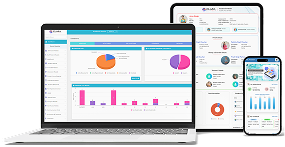Empowering Institutions with Smart Solutions
Helping institutions grow smarter with innovative solutions, simplifying management and boosting productivity.
Get a Live Demo for ERP today!

Top 7 Features Every School ERP Should Have in 2025
5 min. read
In an era where technology is transforming every sector, education is no exception. Schools today face increasing pressure to digitize operations, streamline administration, and provide a modern, connected experience to students, staff, and parents. Enter the School ERP system—a powerful solution that centralizes management and drives digital transformation across institutions.
But with dozens of ERP platforms on the market, how do you decide which one is right for your school? In 2025, it’s not just about digitizing processes—it's about choosing a system that’s flexible, secure, and ready for the future.
Here are the top 7 features every School ERP should offer in 2025:
Gone are the days of bulky, on-premise software. Cloud-based ERP platforms are the gold standard today. They offer secure, real-time access to institutional data across all devices—desktops, tablets, or smartphones. With cloud hosting, schools benefit from automatic updates, improved data backups, disaster recovery, and the ability to scale operations without heavy IT infrastructure investments. Whether you're managing one school or an entire chain, the cloud gives you the flexibility to grow.

In 2025, having a responsive website is not enough. A modern ERP must offer dedicated mobile
apps for students, teachers, parents, and administrators. These apps improve real-time
communication, enhance engagement, and offer instant access to daily functions like
attendance, assignments, exam schedules, fee status, and announcements.
Push notifications keep everyone in the loop, while features like digital homework
submission or leave requests simplify school-parent interactions dramatically.
A great ERP should serve everyone in the ecosystem—without overwhelming anyone. Role-based
dashboards allow users to view and manage information specific to their responsibilities.
For example, a teacher’s dashboard should prioritize class schedules, grading, and student
records, while a parent’s dashboard might focus on attendance, fees, and communication.
Personalization also improves adoption. Look for ERPs that allow schools to customise the
interface, logo, theme, and even workflows based on their unique needs.
Managing fees manually is time-consuming and error-prone. ERP systems today should offer a
fully automated fee collection module—handling everything from fee structures, late fines,
concessions, and scholarships to dues tracking and receipts.
Integration with secure payment gateways (UPI, cards, wallets) provides parents with
convenience and reduces collection delays. Real-time tracking and audit logs also help
finance teams stay compliant and transparent.
Automation in attendance is no longer optional—it’s a necessity. A modern ERP should
integrate with smart hardware like RFID cards or biometric scanners to record accurate
attendance data in real time. This minimizes errors, improves security, and saves valuable
classroom time.
The system should be configured to send instant SMS or app notifications to parents about
absenteeism or late arrivals, reinforcing student safety and accountability.
Strong communication builds trust—and an ERP system must support it. Look for platforms with
integrated tools like SMS alerts, push notifications, emails, chat modules, circular
distribution, and event calendars.
Some ERPs also offer forums, class feeds, or internal messaging systems to encourage
collaboration between teachers and students. These tools make communication more organized
and accessible, replacing cluttered WhatsApp groups and paper notices.
In a data-driven world, having access to the right insights can transform decision-making.
School leaders should be able to view academic trends, attendance rates, fee collection
metrics, and performance summaries in real-time.
Advanced ERP systems offer customizable reports, visual dashboards, and exportable data
formats that help administrators track progress, identify gaps, and improve operations.
AI-powered suggestions and alerts are becoming increasingly common—and should be on your
radar.
Choosing the right School ERP in 2025 is about more than just ticking checkboxes. It's about
selecting a platform that aligns with your long-term vision—whether that’s better parent
communication, smarter analytics, or simplified admin workflows.
The ideal ERP will be flexible, mobile-friendly, cloud-native, and secure—designed to grow
with your institution. If you’re planning a digital upgrade, keep these features in mind to
ensure your ERP investment is both smart and future-ready.
Learn More
Learn More
Learn More
Learn More
Transform your operations with innovative solutions designed for efficiency, growth, and success. Let’s create something extraordinary together.
